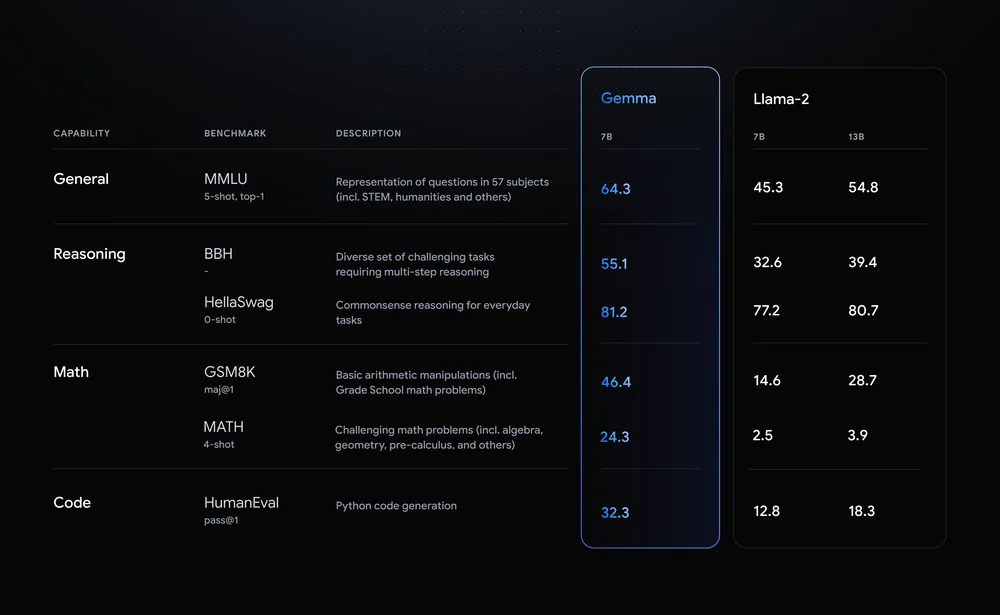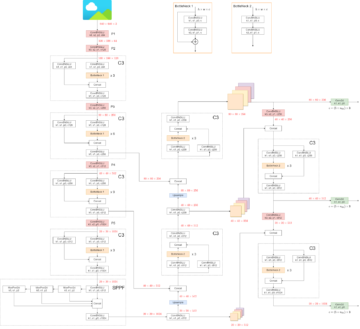Google has been a frontrunner in AI research, contributing significantly to the open-source community with transformative technologies like TensorFlow, BERT, T5, JAX, AlphaFold, and AlphaCode. Continuing this legacy, Google has introduced Gemma, an LLM built for responsible AI development, leveraging the same research and technology that powered the Gini models.
Table of contents
What is Gemma LLM?
Gemma stands out with its impressive performance metrics. It comes in two variants: one with 7 billion parameters and another with 2 billion. When compared to Meta’s LLM, Llama 2, Gemma shows superior accuracy across various benchmarks. For instance, Gemma’s 7 billion parameter model boasts a general accuracy of 64.3%, outperforming Lama 2 in reasoning, math, and other categories.

Let’s look at some of the features of Gemma LLM:
- Lightweight Architecture: Gemma comes in two sizes, 2B and 7B parameters, significantly smaller than its larger cousins. This translates to faster inference speeds and lower computational demands, making it ideal for personal computers and even mobile devices.
- Open-Source Availability: Unlike many high-performance LLMs, Gemma’s code and parameters are freely available, empowering developers and researchers to experiment, customize, and contribute to its evolution.
- Instruction-tuned Variants: Beyond pre-trained models, Gemma offers “instruction-tuned” versions optimized for specific tasks like question answering and summarization. This enhances performance and adaptability for real-world applications.
Gemma’s impact goes beyond technical specs. It democratizes access to advanced LLMs, fostering innovation and collaboration within the AI community. Its potential applications span diverse fields, from personal productivity tools and chatbots to code generation and scientific research. By lowering barriers to entry, Gemma holds the promise to accelerate progress in natural language processing and shape the future of AI.
Diving Deep into Gemma Variants
Gemma, Google’s open-source LLM family, offers a versatile range of models catering to diverse needs. Let’s delve into the different sizes and versions, exploring their strengths, use cases, and technical details for developers:
Size Matters: Choosing Your Gemma
- 2B: This lightweight champion excels in resource-constrained environments like CPUs and mobile devices. Its memory footprint of around 1.5GB and fast inference speed makes it ideal for tasks like text classification and simple question answering.
- 7B: Striking a balance between power and efficiency, the 7B variant shines on consumer-grade GPUs and TPUs. Its 5GB memory requirement unlocks more complex tasks like summarization and code generation.
Tuning the Engine: Base vs. Instruction-tuned
- Base: Fresh out of the training process, these models offer a general-purpose foundation for various applications. They require fine-tuning for specific tasks but provide flexibility for customization.
- Instruction-tuned: Pre-trained on specific instructions like “summarize” or “translate,” these variants offer out-of-the-box usability for targeted tasks. They sacrifice some generalizability for improved performance in their designated domain.
Technical Tidbits for Developers
- Memory Footprint: 2B models require around 1.5GB, while 7B models demand approximately 5GB of memory. Fine-tuning can slightly increase this footprint.
- Inference Speed: 2B models excel in speed, making them suitable for real-time applications. 7B models offer faster inference compared to larger LLMs but may not match the speed of their smaller siblings.
- Framework Compatibility: Both sizes are compatible with major frameworks like TensorFlow, PyTorch, and JAX, allowing developers to leverage their preferred environment.
Matching the Right Gemma to Your Needs
The choice between size and tuning depends on your specific requirements. For resource-constrained scenarios and simple tasks, the 2B base model is a great starting point. If you prioritize performance and complexity in specific domains, the 7B instruction-tuned variant could be your champion. Remember, fine-tuning either size allows further customization for your unique use case.
Remember: This is just a glimpse into the Gemma variants. With its diverse options and open-source nature, Gemma empowers developers to explore and unleash its potential for various applications.
Getting Started with Gemma
Gemma, Google’s impressive family of open-source large language models (LLMs), opens doors for developers and researchers to explore the potential of AI at their fingertips. Let’s dive into how you can install and run Gemma, access pre-trained models, and build your own applications using its diverse capabilities.
Platform Agnostic: Gemma on CPU, GPU, or TPU
Gemma boasts platform flexibility, allowing you to run it on various hardware configurations. For CPU-based setups, the Hugging Face Transformers library and Google’s Tensorflow Lite interpreter offer efficient options. If you have access to GPUs or TPUs, leverage TensorFlow’s full power for accelerated performance. For cloud-based deployments, consider Google Cloud Vertex AI for seamless integration and scalability.
Access Ready-to-Use Models
Gemma’s pre-trained models come in various sizes and capabilities, catering to diverse needs. For text generation, translation, and question-answering tasks, Gemma 2B and 7B variants offer impressive performance. Additionally, instruction-tuned models like Gemma 2B-FT and 7B-FT are specifically designed for fine-tuning your own datasets, unlocking further personalization.
Explore Gemma’s Capabilities
Let’s explore some exciting applications you can build with Gemma:
- Captivating Storytelling: Generate realistic and engaging narratives using text generation capabilities.
- Language Translation Made Easy: Translate text seamlessly between languages with Gemma’s multilingual prowess.
- Unveiling Knowledge: Implement question-answering models to provide informative and insightful responses.
- Creative Content Generation: Experiment with poetry, scripts, or code generation, pushing the boundaries of creative AI.
Fine-Tuning and Customization
Gemma’s true power lies in its fine-tuning capabilities. Leverage your own datasets to tailor the model to your specific needs and achieve unparalleled performance. The provided reference articles offer detailed instructions on fine-tuning and customization, empowering you to unlock Gemma’s full potential.
Getting started with Gemma is an exciting journey. With its accessible nature, diverse capabilities, and vibrant community support, Gemma opens a world of possibilities for developers and researchers alike. So, dive into the world of open-source LLMs and unleash the power of Gemma in your next AI project!
The Future of Gemma
Gemma’s open-source nature and impressive performance have sparked significant buzz within the LLM community.
But what lies ahead for this burgeoning family of models?
- Advancements in the LLM Landscape: Gemma’s open-source nature fosters collaboration and innovation. Researchers and developers worldwide can contribute to its development, accelerating progress in areas like interpretability, fairness, and efficiency. We might see Gemma spearheading the exploration of multi-modal LLMs, capable of processing and generating not only text but also images, audio, and video.
- Optimistic Outlook: With its democratizing approach and impressive capabilities, Gemma represents a significant step towards making AI accessible and beneficial for everyone. As development progresses, we can expect even more groundbreaking applications and advancements. Gemma’s open-source nature fosters a vibrant community, ensuring its continued evolution and impact on the future of LLMs.
Conclusion
Gemma’s arrival in the LLM landscape marks a significant turning point. Unlike its larger, more resource-intensive cousins, Gemma offers accessibility and flexibility, making advanced AI capabilities available to a wider audience. Its open-source nature fuels innovation and collaboration, accelerating progress in natural language processing and shaping the future of AI.
Key Takeaways
- Lightweight and Open-Source: Gemma’s smaller size and open availability make it accessible on diverse platforms, empowering individuals and smaller organizations to explore AI’s potential.
- Diverse Variants and Capabilities: With multiple sizes and instruction-tuned options, Gemma caters to various needs, from basic question answering to complex content generation.
- Unlocking Potential through Customization: Fine-tuning capabilities allow users to tailor Gemma to their specific needs, unlocking new possibilities in diverse fields.
- A Vibrant Community and Bright Future: Gemma’s open-source nature fosters a collaborative community, driving advancements in interpretability, fairness, and multi-modal capabilities.
Important Links
- SEO Powered Content & PR Distribution. Get Amplified Today.
- PlatoData.Network Vertical Generative Ai. Empower Yourself. Access Here.
- PlatoAiStream. Web3 Intelligence. Knowledge Amplified. Access Here.
- PlatoESG. Carbon, CleanTech, Energy, Environment, Solar, Waste Management. Access Here.
- PlatoHealth. Biotech and Clinical Trials Intelligence. Access Here.
- Source: https://www.analyticsvidhya.com/blog/2024/02/gemma-llm/
- :has
- :is
- :not
- 1
- 2%
- 7
- a
- About
- accelerate
- accelerated
- accelerating
- access
- accessibility
- accessible
- accuracy
- Achieve
- across
- Additionally
- advanced
- advancements
- ahead
- AI
- ai research
- alike
- All
- allow
- Allowing
- allows
- also
- an
- and
- Another
- answering
- applications
- approach
- approximately
- architecture
- ARE
- areas
- around
- arrival
- articles
- AS
- At
- audience
- audio
- availability
- available
- Balance
- barriers
- base
- basic
- BE
- been
- benchmarks
- beneficial
- between
- Beyond
- Billion
- boasts
- both
- boundaries
- Bright
- build
- built
- burgeoning
- but
- by
- CAN
- capabilities
- capable
- case
- cases
- categories
- catering
- caters
- champion
- chatbots
- choice
- choosing
- classification
- Cloud
- code
- collaboration
- collaborative
- come
- comes
- community
- compared
- compatibility
- compatible
- complex
- complexity
- computational
- computers
- configurations
- Consider
- content
- continued
- continuing
- contribute
- contributing
- could
- CPU
- Creative
- customization
- customize
- datasets
- deep
- delve
- Demand
- democratizes
- Democratizing
- depends
- deployments
- designated
- designed
- detailed
- details
- developers
- Development
- Devices
- different
- dive
- diverse
- domain
- domains
- doors
- driving
- easy
- efficiency
- efficient
- either
- empowering
- empowers
- engaging
- Engine
- ensuring
- entry
- Environment
- environments
- Even
- everyone
- evolution
- Excel
- exciting
- expect
- experiment
- exploration
- explore
- Exploring
- Face
- fairness
- family
- FAST
- faster
- Features
- Fields
- fingertips
- Flexibility
- Footprint
- For
- fostering
- fosters
- Foundation
- frameworks
- freely
- fresh
- from
- fuels
- full
- further
- future
- Future of AI
- General
- general-purpose
- generate
- generating
- generation
- gini
- Glimpse
- Goes
- Google Cloud
- Google’s
- GPU
- GPUs
- great
- groundbreaking
- Hardware
- Have
- High
- high-performance
- holds
- How
- HTTPS
- ideal
- if
- images
- Impact
- implement
- impressive
- improved
- in
- Increase
- individuals
- informative
- Innovation
- insightful
- instance
- instructions
- integration
- into
- introduced
- IT
- ITS
- journey
- just
- Know
- knowledge
- landscape
- language
- Languages
- large
- larger
- Legacy
- Leverage
- leveraging
- Library
- lies
- lightweight
- like
- Llama
- llm
- Look
- lower
- lowering
- made
- Made Easy
- major
- make
- MAKES
- Making
- many
- Match
- math
- Matters
- max-width
- May..
- Memory
- Metrics
- might
- Mobile
- mobile devices
- model
- models
- more
- multiple
- narratives
- Natural
- Natural Language
- Natural Language Processing
- Nature
- Need
- needs
- New
- next
- of
- offer
- Offers
- on
- ONE
- only
- open
- open source
- opens
- optimized
- Options
- or
- organizations
- Other
- out
- Outlook
- outperforming
- own
- parameter
- parameters
- performance
- personal
- Personal computers
- personalization
- platform
- Platforms
- plato
- Plato Data Intelligence
- PlatoData
- Poetry
- Point
- possibilities
- potential
- power
- powered
- powerhouse
- preferred
- Prioritize
- process
- processing
- productivity
- Productivity Tools
- Progress
- promise
- provide
- provided
- prowess
- Pushing
- pytorch
- question
- range
- real world
- real-time
- realistic
- reasoning
- reference
- remember
- represents
- require
- requirement
- Requirements
- research
- researchers
- resource-intensive
- responses
- responsible
- right
- Run
- sacrifice
- same
- Scalability
- scenarios
- scientific
- scripts
- seamless
- seamlessly
- see
- Shape
- shaping
- shines
- Shows
- significant
- significantly
- Simple
- Size
- sizes
- slightly
- smaller
- So
- some
- span
- sparked
- spearheading
- specific
- specifically
- specs
- speed
- speeds
- stands
- started
- Starting
- Step
- storytelling
- strengths
- suitable
- superior
- support
- tailor
- targeted
- tasks
- Technical
- Technologies
- Technology
- tensorflow
- text
- Text Classification
- text generation
- than
- that
- The
- The Future
- the world
- their
- Them
- These
- they
- this
- Through
- to
- tools
- towards
- Training
- transformative
- transformers
- translate
- Translation
- true
- tuning
- Turning
- turning point
- two
- unique
- unleash
- unlike
- unlock
- unlocking
- unlocks
- unparalleled
- usability
- use
- use case
- users
- using
- Variant
- variants
- various
- versatile
- versions
- vibrant
- Video
- vs
- we
- What
- when
- while
- wider
- with
- within
- world
- worldwide
- you
- Your
- zephyrnet









